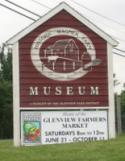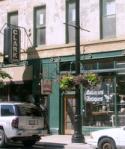CSS Introduction
General Context Sensitive Planning
|
Examples of Context Sensitive |
|
|---|---|
 |
|
 |
Context sensitive solutions-type thinking is not limited solely to transportation planning and engineering. Other tools, usually implemented through zoning and development ordinances, attempt to deal with context sensitivity through components of urban design.
Context Sensitive Signage
One common application is context sensitive signage, which plans for and regulates signs, a prevalent and pervasive aspect of a community. Although the primary purpose of signage is to act as an effective means of communication, its impact on the surroundings can range significantly. Context Sensitive regulations require signs to complement the existing built and natural environments, through height or illumination restrictions, or appearance standards.
Neighborhood Conservation Districts
Municipalities have also been adopting neighborhood conservation overlay districts, e.g. zoning districts which restore, preserve, and protect desired neighborhood character. Often utilized as an alternative to historic district designation, neighborhood conservation overlays are flexible and efficient, and promote infill and redevelopment that complies with modest development standards such as building height, setbacks, roof pitch, garage location, front porches, driveway access, street trees, and landscaping to maintain neighborhood character. These standards can also be set forth in more general design guidelines, which are frameworks adopted as a part of a municipality's zoning ordinance to ensure quality development. (For more information about this, please see CMAP's strategy report on Teardowns.)
Example Neighborhood Conservation District – Chapel Hill, NC
A college town in central North Carolina, Chapel Hill has faced significant growth pressures in recent years. In order to protect unique and distinctive older in-town residential neighborhoods and commercial districts which contribute to the overall character and identity of the town, several neighborhood conservation districts have been established. The town currently has six neighborhood conservation district overlays, protecting a variety of neighborhoods. Some of these districts are designated as historic districts, others may lack sufficient historical, architectural or cultural significance to be designated as Historic Districts. As a matter of public policy, the Chapel Hill Town Council aims to preserve, protect, enhance, and perpetuate the value of these residential neighborhoods or commercial districts. Among other requirements, the district must be at least 75% improved, and platted or developed at least 40 years prior.
Contextual Standards
Flexibility is key in ensuring context sensitivity. This flexibility can be built into zoning ordinances through contextual standards which are used in mature areas where the established development context differs from typical new development geared to meeting minimum development standards. These tailored standards reflect the area's current character, relying on cues from the surroundings rather than hard-and-fast rules.
Example Contextual Standards – New York, NY
New York City has established a number of residential districts termed "contextual" because they maintain the familiar built form of the existing community. These districts are similar to overlays in that they are subsets of the general residential districts (i.e., R2 zoning becomes R2-X if it is contextual). Therefore, the same zoning restrictions apply in regards to minimum lot size and width, but with more flexibility to incorporate context. Floor-area-ratios, bulk, lot coverage, setbacks, scale, and other features can be adjusted to allow for flexibility and integration into the surroundings.
Formula Business Ordinances
Finally, some communities have adopted formula business ordinances. Formula businesses include retail stores, restaurants, hotels and other establishments that are required by contract to adopt standardized services, methods of operation, decor, uniforms, architecture or other features virtually identical to businesses located in other communities. Formula business ordinances do not prevent a chain store from coming in, but they do require that the incoming chain not look or operate like any other branch in the country. This has proved a significant deterrent to chains, which generally refuse to veer from their standardized approach. This helps communities retain their sense of place and uniqueness.
Example Formula Business Ordinance – York, ME 
York, Maine is a small coastal community of about ten miles north of the New Hampshire border. At a town meeting in May 2004, residents of York voted to amend the town's zoning ordinance to prohibit formula restaurants. The measure, which was endorsed by the Planning Board and the Board of Selectmen, notes that York has retained a large concentration of historic buildings and locally owned businesses, and that the town's unique character is important to York's "collective identity as a community."
 A local example is the McDonald's fast-food restaurant on Waukegan Road (IL 43) in West Lake Forest, IL. The traditionally uniform chain restaurant was approved only after significant appearance, landscaping, and signage requirements, giving it a "barn-like" appearance that references Lake Forest's vernacular architecture.
A local example is the McDonald's fast-food restaurant on Waukegan Road (IL 43) in West Lake Forest, IL. The traditionally uniform chain restaurant was approved only after significant appearance, landscaping, and signage requirements, giving it a "barn-like" appearance that references Lake Forest's vernacular architecture.
Although these development tools are gaining support throughout the country and the region, the concept of context sensitivity has been most pervasive in the world of transportation. Thus, CSS is the focus of this analysis.
|
What do you consider to be the most effective form of context sensitive solutions? |

